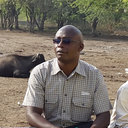Cattle select African savanna termite mound patches less when sharing habitat with wild herbivores.
الكلمات الدالة
نبذة مختصرة
African savanna termite mounds function as nutrient-rich foraging hotspots for different herbivore species, but little is known about their effects on the interaction between domestic and wild herbivores. Understanding such effects is important for better management of these herbivore guilds in landscapes where they share habitats. Working in a central Kenyan savanna ecosystem, we compared selection of termite mound patches by cattle between areas cattle accessed exclusively and areas they shared with wild herbivores. Termite mound selection index was significantly lower in the shared areas than in areas cattle accessed exclusively. Furthermore, cattle used termite mounds in proportion to their availability when they were the only herbivores present, but used them less than their availability when they shared foraging areas with wild herbivores. These patterns were associated with reduced herbage cover on termite mounds in the shared foraging areas, partly indicating that cattle and wild herbivores compete for termite mound forage. However, reduced selection of termite mound patches was also reinforced by higher leafiness of Brachiaria lachnantha (the principal cattle diet forage species) off termite mounds in shared than in unshared areas. Taken together, these findings suggest that during wet periods, cattle can overcome competition for termite mounds by taking advantage of wildlife-mediated increased forage leafiness in the matrix surrounding termite mounds. However, this advantage is likely to dissipate during dry periods when forage conditions deteriorate across the landscape and the importance of termite mounds as nutrient hotspots increases for both cattle and wild herbivores. Therefore, we suggest that those managing for both livestock production and wildlife conservation in such savanna landscapes should adopt grazing strategies that could lessen competition for forage on termite mounds, such as strategically decreasing stock numbers during dry periods.



